Related Research Articles

In botany, a fruit is the seed-bearing structure in flowering plants formed from the ovary after flowering.

A berry is a small, pulpy, and often edible fruit. Typically, berries are juicy, rounded, brightly colored, sweet, sour or tart, and do not have a stone or pit, although many pips or seeds may be present. Common examples are strawberries, raspberries, blueberries, blackberries, red currants, white currants and blackcurrants. In Britain, soft fruit is a horticultural term for such fruits.

An apricot is a fruit, or the tree that bears the fruit, of several species in the genus Prunus.

A plum is a fruit of the subgenus Prunus of the genus Prunus. The subgenus is distinguished from other subgenera in the shoots having terminal bud and solitary side buds, the flowers in groups of one to five together on short stems, and the fruit having a groove running down one side and a smooth stone.

In botany, a drupe is an indehiscent fruit in which an outer fleshy part surrounds a single shell of hardened endocarp with a seed (kernel) inside. These fruits usually develop from a single carpel, and mostly from flowers with superior ovaries.

A prune is a dried plum of any cultivar, mostly the European plum. Use of the term "prune" for fresh plums is obsolete except when applied to varieties grown for drying.

Prunus is a genus of trees and shrubs, which includes the fruits plums, cherries, peaches, nectarines, apricots, and almonds.

Prunus mume is an East Asian and Southeast Asian tree species classified in the Armeniaca section of the genus Prunus subgenus Prunus. Its common names include Chinese plum,Japanese plum, and Japanese apricot. The flower, long a beloved subject in the traditional painting and poetry of East Asia and Vietnam, is usually called plum blossom. This distinct tree species is related to both the plum and apricot trees. Although generally referred to as a plum in English, it is more closely related to the apricot. In East Asian cuisine and Southeast Asian cuisine (Vietnamese), the fruit of the tree is used in juices, as a flavouring for alcohol, as a pickle and in sauces. It is also used in traditional medicine.

Prunus spinosa, called blackthorn or sloe, is a species of flowering plant in the rose family Rosaceae. It is native to Europe, western Asia, and locally in northwest Africa. It is also locally naturalised in New Zealand, Tasmania and eastern North America.
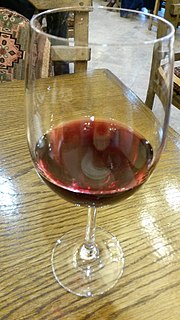
Fruit wines are fermented alcoholic beverages made from a variety of base ingredients ; they may also have additional flavors taken from fruits, flowers, and herbs. This definition is sometimes broadened to include any fermented alcoholic beverage except beer. For historical reasons, mead, cider, and perry are also excluded from the definition of fruit wine.
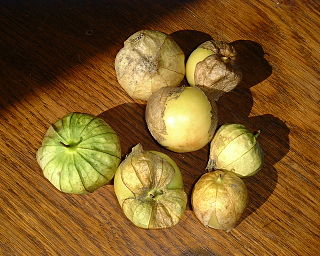
The tomatillo, also known as the Mexican husk tomato, is a plant of the nightshade family bearing small, spherical and green or green-purple fruit of the same name. Tomatillos originated in Mexico and were cultivated in the pre-Columbian era. A staple of Mexican cuisine, they are eaten raw and cooked in a variety of dishes, particularly salsa verde.
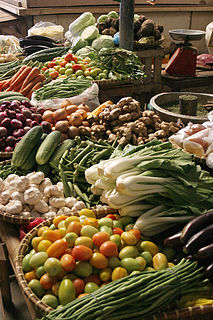
Vegetables are parts of plants that are consumed by humans or other animals as food. The original meaning is still commonly used and is applied to plants collectively to refer to all edible plant matter, including the flowers, fruits, stems, leaves, roots, and seeds. The alternate definition of the term is applied somewhat arbitrarily, often by culinary and cultural tradition. It may exclude foods derived from some plants that are fruits, flowers, nuts, and cereal grains, but include savoury fruits such as tomatoes and courgettes, flowers such as broccoli, and seeds such as pulses.

Knedle, is a dish of boiled potato-dough dumplings filled with plums or apricots, popular in Central and East European countries, especially in Poland, Hungary, Serbia, Croatia, Bosnia-Herzegovina, Romania, Slovakia and Czech Republic. The dish is eaten as dessert, a main dish, or side dish.

The Nanjing cherry is a species of Prunus native to northern and western China, Korea, Mongolia, and possibly northern India. Other common names for P. tomentosa include Korean cherry, Manchu cherry, downy cherry, Shanghai cherry, Ando cherry, mountain cherry, Chinese bush cherry, or Chinese dwarf cherry.
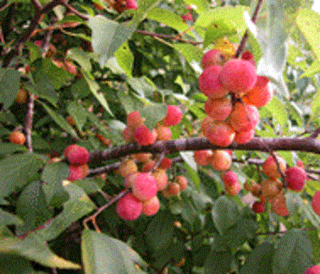
Prunus rivularis, known variously by the common names creek plum, hog plum, or wild-goose plum is a thicket forming shrub. It prefers calcareous clay soil or limestone-based woodland soils. This deciduous plant belongs to the rose family, Rosaceae, and is found mainly in the central United States. It is a shrub consisting of slender stems with umbel clusters of white blossoms. The fruit is a drupe that resembles a large berry; though it has a bitter taste, it serves as a source of food for birds and other wildlife. "Prunus" is Latin for plum, whereas "rivularis" means being near a stream.

Cenarrhenes is a monytypic genus in the family Proteaceae containing the single species Cenarrhenes nitida, known as the Port Arthur plum or native plum. Cenarrhenes nitida is an evergreen shrub to small tree endemic to the rainforests and scrublands of western Tasmania. It bears white flowers in late spring followed by the development of fleshy fruit.
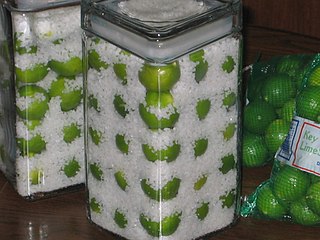
Pickled fruit refers to fruit that has been pickled. Pickling is the process of food preservation by either anaerobic fermentation in brine or immersion in vinegar. Many types of fruit are pickled. Some examples include peaches, apples, crab apple, pears, plums, grapes, currant, tomato and olives. Vinegar may also be prepared from fruit, such as apple cider vinegar.

Plum cake refers to a wide range of cakes made with either dried fruit or with fresh fruit. There is a wide range of popular plum cakes and puddings. Since the meaning of the word "plum" has changed over time, many items referred to as plum cakes and popular in England since at least the eighteenth century have now become known as fruitcake. The English variety of plum cake also exists on the European mainland, but may vary in ingredients and consistency. Settlers in British colonies brought the dried fruit variety of cake with them, so that for example, in India it was served around the time of the Christmas holiday season and in the American colonies, where it became associated with elections, one version came to be called election cake.
Mua people (Mualgal) alternatively the Moa, are an indigenous Australian Torres Strait Island people based on Moa(Banks Island). According to Alfred Cort Haddon their lifestyle, culture, myths and kinship networks overlapped closely with those of the Kaurareg on neighbouring Muralag.

Astragalus crassicarpus, known as ground plum or buffalo plum, is a perennial species of flowering plant in the legume family, Fabaceae, native to North America. It was described in 1813. The fruit is edible and was used by Native Americans as food and horse medicine. It is a host of afranius duskywing larvae. It is also known as groundplum milkvetch and pomme de prairie.
References
- ↑ Philippines Bureau of Science (1934). The Philippine Journal of Science. 34. p. 252.
- ↑ Wilson Popenoe (1920). Manual of Tropical and Subtropical Fruits. New York: The Macmillan Company. pp. 158.
- ↑ Martín de la Cruz and William Gates (2000). An Aztec Herbal: The Classic Codex of 1552. Courier Dover Publications. xvii, 123. ISBN 0-486-41130-3.
- ↑ Louise M. Burkhart (1996). "Commentary on the plays". Holy Wednesday: A Nahua Drama from Early Colonial Mexico. University of Pennsylvania Press. p. 225. ISBN 0-8122-1576-1.
- ↑ Benno P. Warkentin (2006). Footprints in the Soil: People and Ideas in Soil History . Elsevier. pp. 35. ISBN 0-444-52177-1.
| | This article related to indigenous Mesoamerican culture is a stub. You can help Wikipedia by expanding it. |